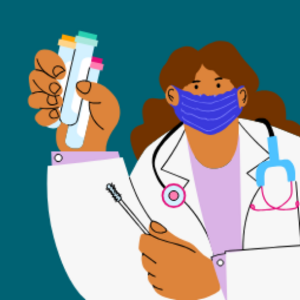
Ensure your health. Get tested today.
Convenient lab testing at your fingertips at more than 5,000 locations nationally. Consult with a doctor, or get tested on your own.

If your doctor has mentioned screening your blood sugar levels, you may be wondering about how to prepare for a glucose test. A glucose test (also called a glucose screening or glucose tolerance test) is a common and important test for those who have symptoms or a family history of diabetes, according to the National Institute of Diabetes and Digestive and Kidney Diseases (NIDDK). This test is also used in pregnant women to screen for gestational diabetes (a condition that causes high blood sugar levels during pregnancy). Below you will find how to prepare for a glucose test, including what to do before, during, and after your test.
There are two types of glucose tests, according to the NIDDK—a fasting glucose test and a two-step glucose tolerance test. They note that a fasting glucose test requires you to avoid eating or drinking anything but water for at least 8 hours before the test. If your fasting glucose test indicates that you may have diabetes, a glucose challenge test can be used to confirm the results. A blood glucose tolerance test is also commonly recommended as a screening test for gestational diabetes. The glucose challenge test is done in two steps:
Glucose tolerance tests work by measuring the level of glucose in your blood. According to the NIH, there are different methods for conducting glucose tests—either by using a small drop of blood with a glucose meter or a laboratory blood test.
A common method of blood glucose testing involves pricking the finger to obtain a small blood sample, which is then placed on a test strip and inserted into a glucose meter. The meter measures the amount of glucose in the blood sample and provides a digital readout of the results within a few seconds, according to the American Diabetes Association (ADA). Another method for testing your blood glucose level is by getting your blood drawn. This is usually done at a doctor’s office or laboratory, according to the ADA.
Another screening test that can be done is a Hemoglobin A1C test. This is a blood test that shows the average of your blood glucose levels over the past three months.
Glucose tests are done to measure the level of glucose (sugar) in the blood. These tests are commonly used as a diabetes screening test for people who have symptoms of diabetes or are at a high risk of developing diabetes. Additionally, blood glucose tests may be conducted to evaluate hypoglycemia (a condition that causes low blood sugar levels), monitor your diabetes treatment, or as part of a general health screening. Glucose tolerance tests are also recommended for all pregnant women by the American Academy of Gynecologists and Obstetricians. According to the American College of Obstetricians and Gynecologists (ACOG), glucose tolerance tests are recommended between 24 and 28 weeks of pregnancy but may be done earlier if a woman has a history of gestational diabetes mellitus.
The results of your blood glucose testing can provide valuable information about your overall health and help your healthcare provider make informed decisions about your care. If you are at a higher risk of developing diabetes, your healthcare provider may recommend getting a diabetes screening. Risk factors, according to the ADA, include:
Preparing for your glucose test depends on which type of glucose test you are having done. A screening test that measures fasting blood glucose will require you to avoid eating or drinking anything but water, for example. The preparation steps listed below are typical, according to the NIH—but it is important to follow any specific instructions provided by your healthcare provider.
A 1-hour glucose test is usually used as a first-line test for people who have an increased risk of type 2 diabetes or gestational diabetes. According to the NIH, there is no specific preparation needed for the 1-hour glucose test. When you arrive for your test, you will have to drink a liquid that contains glucose (usually called “Glucola”). 1 hour after you drink the Glucola, you will have your blood drawn to assess your blood sugar levels.
3-hour glucose testing is usually recommended if you had a result that was out of range in a previous test or certain risk factors. This test takes a little more preparation, according to the NIH:
Each time you get your blood drawn, the laboratory or healthcare provider will make a note of your blood glucose level. This test will tell your healthcare provider how your blood sugar levels are over a period of time.
There is very little risk involved with getting a diabetes screening, according to the NIH. They note that there is a small risk associated with having your blood drawn and that some people may be more prone to feel discomfort than others.
The NIH notes that risks associated with having blood drawn are small, but may include:
The NIH notes that overall the risks associated with high blood sugar levels from undiagnosed diabetes are far higher than the risks associated with the test itself. Undiagnosed gestational diabetes increases several risks to your pregnancy, including preterm birth, having a large baby, and having a baby with abnormal blood glucose levels.
Before getting a blood glucose test, you’ll want to eat foods that help keep your blood sugar stable. According to the NIH, foods that are low carb or have healthy, complex carbs are a great choice. Foods that are higher in fiber are also a good choice. Examples of healthy carbs and higher-fiber foods include:
Adding protein-filled foods to your diet will also help stabilize your blood sugar and curb hunger. Examples of high-protein foods include low-fat dairy products, nuts, fish, or lean meat like chicken.
Before a glucose test, it is generally recommended that you avoid consuming certain foods that can significantly impact blood glucose levels. This includes foods high in refined carbohydrates and sugary foods (such as baked goods, candies, sugary drinks, and fruit juices). Additionally, the NIH notes that you should avoid high-carbohydrate meals and snacks, as well as alcohol, before your screening.
Following these food restrictions can ensure that your diabetes screening provides an accurate reflection of your body's glucose levels. Your healthcare provider may give you more specific guidelines, based on your individual needs.
You may be able to get a glucose tolerance test at urgent care. Find an urgent care near you with Solv.
A glucose test is used to screen for diabetes and gestational diabetes, and to monitor blood sugar levels.
The two types of glucose tests are a fasting glucose test and a two-step glucose tolerance test.
Preparation depends on the type of test. For a fasting glucose test, you should avoid eating or drinking anything but water for at least 8 hours before the test. For a glucose tolerance test, you may need to consume a sugary drink.
Before a glucose test, eat foods that stabilize blood sugar, like whole grains, non-starchy vegetables, fresh fruit, and lean proteins. Avoid foods high in refined carbohydrates and sugar.
The risks associated with glucose tests are minimal and may include bleeding, fainting or feeling lightheaded, multiple punctures to locate veins, hematoma, and infection.

Convenient lab testing at your fingertips at more than 5,000 locations nationally. Consult with a doctor, or get tested on your own.